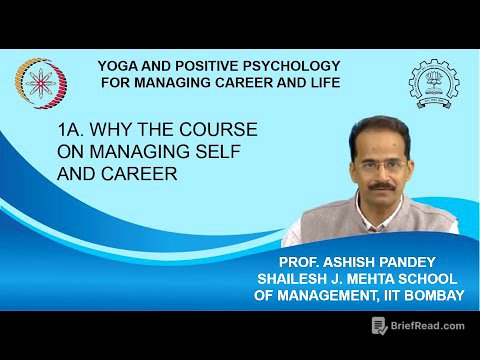TLDR;
This video explains that lower back pain is often a symptom of a larger movement problem in the body, not an issue with the back itself. Static stretching is often ineffective because it doesn't address the root cause. The video introduces three exercises designed to rebuild your foundation by improving stability, control, and movement patterns.
- Lower back pain is often a symptom of a larger movement problem.
- Static stretching is often ineffective.
- Three exercises are introduced to improve stability, control, and movement patterns.
Introduction: The Real Cause of Back Pain [0:00]
The video starts by stating that static stretching often fails to alleviate lower back pain because it doesn't address the underlying issue. The real problem isn't the back itself, but rather a dysfunctional movement system. Weak hip flexors, inactive glutes, and poor posture lead to mechanical and movement compensations, resulting in chronic back pain. The spine ends up bearing excessive pressure due to these dysfunctions.
The Importance of Spinal Movement [2:13]
The video highlights that most people don't train their spine to move through its full range of motion. Daily life and typical gym routines often involve limited rotation, bending, and extension. The spine is designed for complex movements like rotation, flexion, extension, and side bending. When these movements are lacking, the spine stiffens and becomes vulnerable to pain. Tightness is often a result of weakness and instability, and stretching a weak muscle can lead to further injury.
Exercise 1: Lizard Rotation [3:31]
The first exercise, called the "lizard rotation," involves getting into a long lunge position with both hands next to the front foot. After stretching, the outside hand is threaded through, twisting to the opposite side. This exercise aims to create cracking and popping noises, which are beneficial. It's important to keep the back leg close to the ground and stabilize the hips and core to maintain position. This can be done for 10-12 reps or for one minute on each side, focusing on matching the weaker side to the stronger side.
Exercise 2: Spinal Flexion with Rotation [4:46]
The second exercise focuses on spinal flexion. You can use body weight if you have limited mobility, or add a barbell or weight for a deeper stretch and increased strength. While flexing as far as possible, bounce to either side in the bottom position. The goal is to eventually perform these bounces dynamically. After a few bounces, flex back up to a standing position using a Jefferson curl. This exercise builds resilience and robustness in the spine through rotation and dynamic movement. Perform for 5-7 reps or for one minute.
Exercise 3: Quadripedal to Tabletop Rotation [6:12]
The third exercise, the "quadripedal to tabletop rotation," works both protraction and extension in the spine. Start on all fours and protract the shoulder blades, pushing the ground away. Thread one leg through and rotate, keeping the hips high and extending them towards the sky. Avoid arching the lower back and keep the pelvis tucked. Return to the starting position and repeat on the other side. This exercise strengthens the hips, glutes, ankles, shoulders, core, and back, promoting overall body strength and stability.
Conclusion: Movement for a Better Body [7:44]
The video concludes by emphasizing that these exercises retrain the body to work as a system, creating space in the hips, control in the spine, and stability in the core. The goal is to build strength, robustness, and resilience, allowing the body to move as it's designed to, which reduces pain. The video encourages viewers to try these exercises for just 5 minutes a day and observe how their body responds.







![혼자 있을 때 가장 행복한 한국인들...? 대한민국은 어쩌다 관용이 제일 없는 나라 됐을까? ㅣ경쟁 교육 2부 [이게웬날리지]](https://wm-img.halpindev.com/p-briefread_c-10_b-10/urlb/aHR0cDovL2ltZy55b3V0dWJlLmNvbS92aS85REdteU9oRHNFay9ocWRlZmF1bHQuanBn.jpg)

